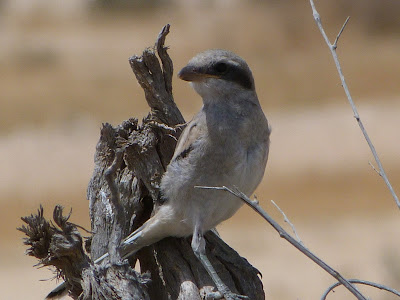Day 5 - 15 April
Another try in the Matash area with some additional nets as we had a slightly larger team. The area was drying out a bit and we moved our base to a more convenient location. The birds began to move just as the last nets were set and we began to extract. There were still quite a few black and white flycatchers present with the first Spotted Flycatcher of the year. We had a good selection of warblers including three Barred Warblers, also new for our visit. CL brought in the first Common Cuckoo for the site.
6M Common Cuckoo
Spotted Flycatcher
5M Barred Warbler
5F Barred Warbler
The session was open to the public and some young families came early on to learn about the birds.
Later we were joined by a large group that had come up from Eilat.
Totals: 114 (9)
Common Cuckoo - 1
Nightingale -2Graceful Prinia - 0 (1)
Eastern Olivaceous Warbler - 5 (5)
Eastern Orphean Warbler - 1
Barred Warbler - 3
Lesser Whitethroat -3 (1)
Blackcap - 85 (1)
Eastern Bonelli's Warbler -1
Wood Warbler -1
Spotted Flycatcher - 1
Collared Flycatcher -7
Masked Shrike -2
Greenfinch - 2
In the afternoon we headed into the Great Makhtesh hoping for some more species. To our surprise, and theirs, we came across a small group of Nubian Ibex on a bend in the road down the side of the crater.
The Great Makhtesh
Nubian Ibex
Nubian Ibex kids
We continued, finding the small wadi that had held so much just a few days before completely dry, and almost birdless, except for six Bee-eaters flying through. As we continued there were 3 Mourning Wheatear, Alpine Swift, Kestrel and Desert Lark but nothing new for the trip. The coloured sands parking area was filled with cars, campers and people - so we drove on. We parked and walked to an oasis in a gorge, that from the level where rubbish had been deposited and recent rock fall must have been a raging torrent of some depth during the flash floods.
Ein Yorge'am
There was a lot of disturbance with people attracted by the muddy waters and we saw fewer birds than expected, just Little Green Bee-eater, Blackstart, Mourning Wheatear and Arabian Babbler- new for the trip.
Day 6 16 April
Today there was no ringing at Yeruham as it was the Shabbat. We had the offer to ring at another town, but we had already planned to travel for sandgrouse coming in for a morning drink at a regular site. On the way saw a few White Stork close to the road.
At the very small pond there were Blackcaps in the bushes and a Montagu's Harrier hunting over reeds. A column of White Storks were rising on a thermal.
White Stork
Finding the sewage ponds was a little difficult as the track ran from another into a dairy farm. We missed it at first, but found it on the second try then followed the track and arrived in time.
Kmehim Sewage Ponds
The birds usually arrive between 7.30am and 9am - with no evening visit. Some people have had hundreds of birds dropping in to drink and four species (Black-bellied, Pin-tailed, Spotted and Crowned) have been seen. We saw nothing like that number, perhaps due to the recent rain that had still not completely dried up providing many additional drinking opportunities. We only got Black-bellied and Pin-tailed Sandgrouse, the two species we had already seen at other locations.
Black-bellied Sandgrouse
Pin-tailed Sandgrouse
Migrant Painted Lady
We left just after 9am as we had other birds to find in challenging conditions. We passed the ruins of Nizzana, a Nabataean city as we travelled to check an old sewage pond.
Nizzana ruins
At the very small pond there were Blackcaps in the bushes and a Montagu's Harrier hunting over reeds. A column of White Storks were rising on a thermal.
Kettling White Storks
We began scouring the desert as the temperature soared to 32C. The vehicle was rather limiting and several tracks were out of our scope. We did manage to see Dorcas Gazelle off in the hazy distance.
The heat conspired against us and we failed to see the speciality birds we hoped, although Steppe Eagle was new for us.
Steppe Eagle
Arabian Babbler and barbed wire - the second being more
common than the first, close to the Israeli Egyptian border.
common than the first, close to the Israeli Egyptian border.
Steppe Buzzard
Recently fledged Southern Grey Shrike
This bird proved difficult, singing in the open, but on moving it was identified as a Rufous Bush Robin.
Rufous Bush-Robin
Day 7 17 April
We moved to an area where Mulberry trees had begun to fruit. Several nets were put up at half the usual height again. The nets caught well and we topped the hundred mark again.
After ringing and a rest we headed to some nearby fields at Sede Boker and hoped to have more luck than we had had on our first try in the rain. We had some good views of Desert Finch, Bee-eater, Eurasian Sparrowhawk and more White Storks.
Here we go round the mulberry trees.
5M Tristram's Grackle
Collared Dove
Palestine Sunbird age 3
Golden Oriole 5M
Thrush Nightingale
Totals: 114 (2)
Collared Dove - 2
Thrush Nightingale - 3
Graceful Prinia - 1
Graceful Prinia - 1
Eastern Olivaceous Warbler - 5
Eastern Orphean Warbler - 1
Barred Warbler - 4
Lesser Whitethroat -5
Garden Warbler - 1
Blackcap - 71 (2)
Blackcap - 71 (2)
Collared Flycatcher - 1
Palestine Sunbird - 1
Tristram's Grackle - 15
Golden Oriole - 1
Greenfinch - 2
Palestine Sunbird - 1
Masked Shrike -1
Golden Oriole - 1
Greenfinch - 2
Desert Finches, plus one Greenfinch
Bee-eaters with White Storks in background.






































